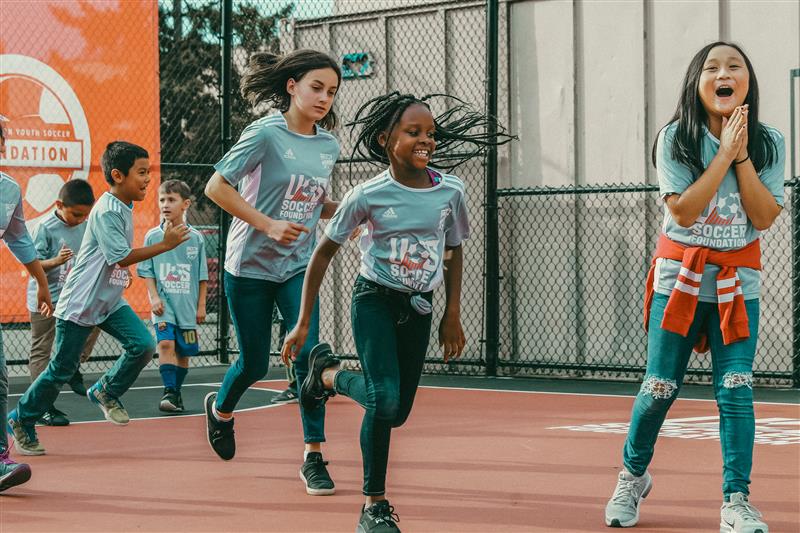

Donate so kids have a place to belong.
A little soccer can make a big difference in kids' futures. With only a few dollars, you can be the difference maker in millions of kids' lives.
Ensuring Health Equity in Return to Play
The final day of the U.S. Soccer Foundation’s 2020 Virtual National Training plenary focused on ensuring health equity as we return to play and reimagine the future of youth sports. The inspiring session stressed creative collaborations, the importance of getting involved on the local level, and the need for inclusivity.
The panel was moderated by Ed Foster-Simeon, President & CEO of the U.S. Soccer Foundation. Foster-Simeon was joined by panelists Justin Bredeman, Soccer Shots CEO; Dr. George Chiampas, U.S. Soccer Federation Chief Medical Officer; Dr. Jane L. Delgado, President and CEO of the National Alliance for Hispanic Health; and Kellie May, National Recreation and Park Association’s Vice President of Programs and Partnerships
“In this time, I can’t think of a topic more important than this – health and equity,” said Foster-Simeon. “One of the key considerations as people return to play is understanding the larger role sport plays in health.”
“If this moment in time doesn’t highlight the importance of physical activity for the social and emotional health of kids, then we’re failing them,” said Dr. Chiampas. “It’s important for us as leaders to highlight to public health officials the importance of physical health activity. We have to all sit down together and make a really scientific and educated decision for the health and safety of our youth. ”
Dr. Delgado stressed that we have the opportunity to reset everything. She said that we need to think beyond the next few months and beyond the cleaning precautions. “Children need interaction. They need to be social in body, mind, and spirit,” she said. “It’s all together. That’s what health is. We can’t compartmentalize it. We need to integrate it.”
The negative health impact has been the greatest in Black and Hispanic communities, Foster-Simeon cited, in part because these communities have been underserved. Policy changes are one way to drive toward long-term, systemic change.
Dr. Delgado offered two ideas. First, the federal government needs to speak with one voice, she said. Second, many decisions are made locally, and organizations need to get involved at the local level.
“The rubber meets road at the local level when it comes to COVID-19. It’s not just children, it is the whole ecosystem environment,” she added.

May started off by recognizing that parks and recreation departments have been a big part of helping residents get outside and exercise throughout the COVID-19 pandemic. She stressed the importance of having a response and communications plan in place if faced with positive cases. One approach that has been working, she said, is ensuring that children and staff remain in the same group or team for the entire length of camp or program and to limit participants.
Foster-Simeon brought up the question of how to be prepared to return to play and Bredeman had some innovative approaches. “Nobody had a blueprint for the pandemic,” he said. “Things came to an abrupt halt and we pivoted quickly to a video offering that included standard guidelines and allowing for variances. We created a playbook with coach modifications – field spacing, curriculum, a lot of precautions. We realized the need to communicate and keep communicating.” Soccer Shots also went hyper-local after realizing that accessibility is one of the biggest challenges.
When the topic of safe places to play and accessibility came up, especially in underserved communities, the panelists had some insightful pointers and ideas.
“It’s not just about access in terms of physical access,” May said. “It’s about that welcoming environment, creating those inclusive spaces where all community members are welcome.”
“Access has to be during hours when people can actually go there,” Dr. Delgado added. “It’s not just about being open. It’s about being welcoming and being welcoming is being open when people can actually go,” she said.
“How do we take advantage of a fantastic time for collaboration?” asked Bredeman. “Are we open to thinking creatively and collaborating with those we normally wouldn’t consider?”
The panelists provided insight on what must change in order to create more opportunities for kids to participate and how we can broaden the lens of what sports can be and mean for community members.
A few actions, panelists said, are to educate public health officials about sport and implement soccer in schools and in conjunction with parks and rec departments.
“Once [public health officials] understand the benefits of the sport that can be cost free and accessible, that’s when we can implement it in our school systems,” Dr. Chiampas said.
“I am inspired by the moment,” Foster-Simeon said as he was concluding the final plenary day. “There is a huge opportunity for the future. The challenge is not losing the momentum and go back to where we were.”
